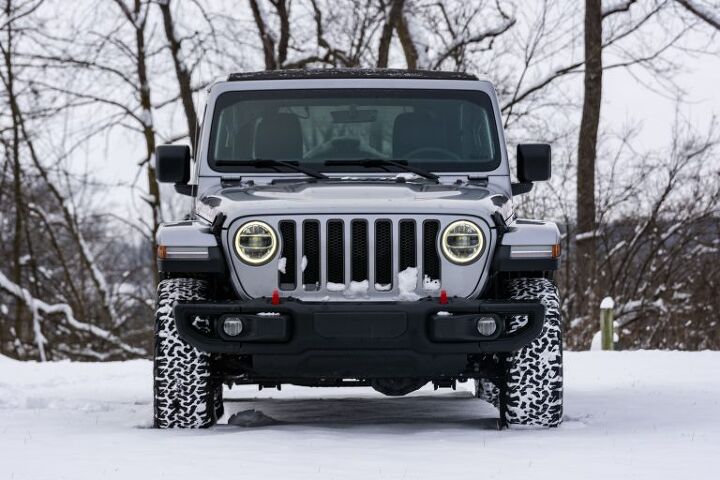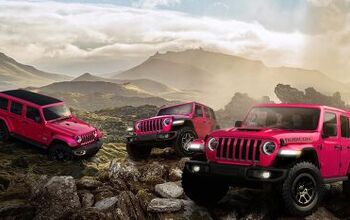2018 Jeep Wrangler Unlimited - The First-ever Cool Hybrid

2018 Jeep Wrangler Unlimited Rubicon
I want first to apologize to the Jeep owners of northern Columbus, and by extension all brethren of the seven-slot grille everywhere. In my week driving this 2018 Jeep Wrangler Unlimited, I neglected to properly wave in most cases.
It’s a Jeep thing, and apparently I don’t understand.
I suppose it’s an ethical thing — can I be a properly unbiased journalist if I gonzo myself into the Jeep subculture? Moreover, is this, a Jeep Wrangler with a hybrid system, a proper Jeep?
No, I’m not kidding. Jeep hasn’t highlighted the hybrid system in marketing this new powertrain, preferring use of the less-specific “eTorque” moniker. Mated to a 2.0-liter turbocharged four-cylinder (related to the Alfa Romeo Giulia four), the hybrid system allows for automatic stop-start, regenerative braking, and engine cut-off during coasting, while adding a bit of torque to the already stout mill.
Interestingly, the peak horsepower of this turbo engine is rather close (270 hp to 285 hp) to the 3.6-liter Pentastar V6, but the torque is a more noticeable difference. The turbo produces 295 lb-ft at 3,000 rpm, while the V6 can only manage 260 lb-ft at a relatively high 4,800 rpm.
I discussed the engine mix with Trevor Dorchies, manager of product communications at Jeep, and he tells me that 40 percent of new Wrangler customers choose the 2.0-liter turbo, likely due to the combination of additional torque and slightly improved fuel economy. Unfortunately for purists, opting for the four-cylinder removes the option of a manual transmission.
My testing, while obviously not under rigorous controlled situations, revealed fuel economy that wasn’t spectacular. While the EPA rates this combo at 22 mpg combined, I only managed 19.9 mpg. Much of my drive was limited to two-lane roads under 50 mph, with a significant portion shifted into four-wheel drive high range due to a larger-than-expected snowstorm. With a better mix of highway driving and less crappy weather, I’d expect a better economy result.
The start-stop system worked quite well, other than one minor annoyance. When the engine did restart while still sitting at a long light, it did so with a palpable lurch. It was never audible, but I’d feel a slight bump, as if the Jeep had been tapped on the bumper. Considering the awful roads and the awful drivers (seriously, I saw a driver stuck trying to ascend an icy hill, foot to floor, smoking a front tire, sawing at the wheel with one hand and phone firmly in ear with the other), I honestly thought I had been bumped in the rear a couple of times. It’s something I’m sure I’d get used to after a short while.
If you look at Jeep’s build and price tool, the turbo engine is listed as a thousand-dollar option over the V6. That’s a bit misleading, however, as the eight-speed automatic is required when selecting the turbo — that’s another two grand, making the hybrid a three thousand dollar proposition. The eight-speed shifts smoothly, and I never noticed it hunting for a ratio. But many Jeep buyers seem to be the sort to shift for themselves, and that option can knock a few grand off the top of the eye-popping sticker on this well-equipped Rubicon trim.
Speaking of big money, my tester was equipped with the Sky One-Touch power top — basically a sliding soft sunroof for the removable hard top. It’s a lovely option, since lowering a Jeep soft top can be a time-consuming endeavor. A button press and the top slides back, while the rear quarter windows can be removed rather easily for a good open-air experience. If you’ll notice the white stuff on the ground, however — you can imagine that I spent very little time with the top retracted.
Even with windows and top closed, the Sky One-Touch power top doesn’t eliminate road noise like most SUVs — the rush of wind and of other traffic noise will be noticeable, but muted. As the top is a $3,995 option, I’d suggest test driving several different top types before committing yourself and your new car loan.
Driving the Jeep Wrangler Unlimited is a much better experience than the few older-generation Wranglers I’ve experienced. Other than a slight bounciness to the ride, which is to be expected from the combination of stiff off-road focused springing and tall sidewalls, the Jeep drives quite nicely on road. It’s not a sports car, but it’s much more willing to change direction at the whim of the driver, rather than that of a loose steering box and sloppy knobby tires often found on older Jeeps.
Basically, what I’m saying is if you’ve only experienced older, more agricultural Jeeps, you owe it to yourself to drive the new JL-chassis Wrangler. A few bad experienced turned me off the brand, but this new design has turned me around.
Were I to build my own Wrangler Unlimited — and yes, I’d choose the four-door Unlimited over the two-door model since I’m quite often hauling the family and need the rear-seat legroom — I’d likely choose the Sport S trim, V6, manual. Sport S gives me the option of the $995 bigger touch screen with Apple CarPlay and Android Auto, as well as 17-inch alloy wheels, the $595 limited-slip rear differential, and $995 active safety group (blind-spot and cross-path detection, mostly). All in, I’d be driving a well-equipped four-door Wrangler for just under $39k.
And yes, I’d choose the teal — Bikini Pearl, Toledo calls it.
Were I to choose the automatic transmission, there’s no question I’d spring for the hybrid four-cylinder. The low-end torque is addictive. My wife hates driving a manual, and I’m pretty certain I’d have to fight her for the keys, so realistically my imaginary teal Jeep Wrangler Unlimited would be a green hybrid.
You can tell the uppity neighbors that it’s just like a Prius.
[Images: © 2019 Chris Tonn/TTAC, screenshot via jeep.com]

Some enthusiasts say they were born with gasoline in their veins. Chris Tonn, on the other hand, had rust flakes in his eyes nearly since birth. Living in salty Ohio and being hopelessly addicted to vintage British and Japanese steel will do that to you. His work has appeared in eBay Motors, Hagerty, The Truth About Cars, Reader's Digest, AutoGuide, Family Handyman, and Jalopnik. He is a member of the Midwest Automotive Media Association, and he's currently looking for the safety glasses he just set down somewhere.
More by Chris Tonn
Latest Car Reviews
Read moreLatest Product Reviews
Read moreRecent Comments
- Teddyc73 Oh look dull grey with black wheels. How original.
- Teddyc73 "Matte paint looks good on this car." No it doesn't. It doesn't look good on any car. From the Nissan Versa I rented all the up to this monstrosity. This paint trend needs to die before out roads are awash with grey vehicles with black wheels. Why are people such lemmings lacking in individuality? Come on people, embrace color.
- Flashindapan Will I miss the Malibu, no. Will I miss one less midsize sedan that’s comfortable, reliable and reasonably priced, yes.
- Theflyersfan I used to love the 7-series. One of those aspirational luxury cars. And then I parked right next to one of the new ones just over the weekend. And that love went away. Honestly, if this is what the Chinese market thinks is luxury, let them have it. Because, and I'll be reserved here, this is one butt-ugly, mutha f'n, unholy trainwreck of a design. There has to be an excellent car under all of the grotesque and overdone bodywork. What were they thinking? Luxury is a feeling. It's the soft leather seats. It's the solid door thunk. It's groundbreaking engineering (that hopefully holds up.) It's a presence that oozes "I have arrived," not screaming "LOOK AT ME EVERYONE!!!" The latter is the yahoo who just won $1,000,000 off of a scratch-off and blows it on extra chrome and a dozen light bars on a new F150. It isn't six feet of screens, a dozen suspension settings that don't feel right, and no steering feel. It also isn't a design that is going to be so dated looking in five years that no one is going to want to touch it. Didn't BMW learn anything from the Bangle-butt backlash of 2002?
- Theflyersfan Honda, Toyota, Nissan, Hyundai, and Kia still don't seem to have a problem moving sedans off of the lot. I also see more than a few new 3-series, C-classes and A4s as well showing the Germans can sell the expensive ones. Sales might be down compared to 10-15 years ago, but hundreds of thousands of sales in the US alone isn't anything to sneeze at. What we've had is the thinning of the herd. The crap sedans have exited stage left. And GM has let the Malibu sit and rot on the vine for so long that this was bound to happen. And it bears repeating - auto trends go in cycles. Many times the cars purchased by the next generation aren't the ones their parents and grandparents bought. Who's to say that in 10 years, CUVs are going to be seen at that generation's minivans and no one wants to touch them? The Japanese and Koreans will welcome those buyers back to their full lineups while GM, Ford, and whatever remains of what was Chrysler/Dodge will be back in front of Congress pleading poverty.












































Comments
Join the conversation
"You can tell the uppity neighbors that it’s just like a Prius." This is a terrible idea, but not for the reason most people think. Back around 2005ish, GM marketing essentially tried the same thing with the 1st "Malibu Hybrid". I put this into quotes because it was a belt-alternator-starter (BAS) e-assist system with a 36V traction battery (like a golf cart battery), not a real hybrid. GM was laughed off the green car block, until the Chevy Volt concept debuted. Why did this happen? First, a real hybrid is able to move the car on just the battery, if only for a short distance. BAS systems are perfectly worthwhile fuel saving technology, but they're just not in the same league as Toyota's Hybrid Synergy Drive. Second, GM learned from their market research that many hybrid drivers like to make an environmental statement. But they didn't problem deeply enough to realize that environmentalists can read the MPG sticker in the window, and environmentalists assume everyone else does too. So, accordingly, GM plastered their Malibu Hybrid (not-really-hynrid) and Tahoe Hybrid (really, really) vehicles with giant lime green "hybrid" stickers -- because, statement. They shouted as loudly as they could that it was just as good as a Prius. But, 20MPG and 33MPG are not 50MPG, and so these vehicles weren't taken seriously by the green car community. The e-torque system is closer to a BAS system than the HSD, and so marketing it the way they do is the right call for Jeep, lest they repeat GM's self-inflicted errors. That said, I'm eagerly following the rumors of a plugin hybrid JL (or JLT?). I'm fascinated by Jeeps, but I can't rationalize owning one. But a Wrangler PHEV might make a good "midlife crisis" vehicle. :-)
The first-ever cool hybrid? What about the whole batch of hybrid super cars that came out a few years ago? Maybe you meant first cool AND accessible hybrid? Even still, the price is a bit too high for that.